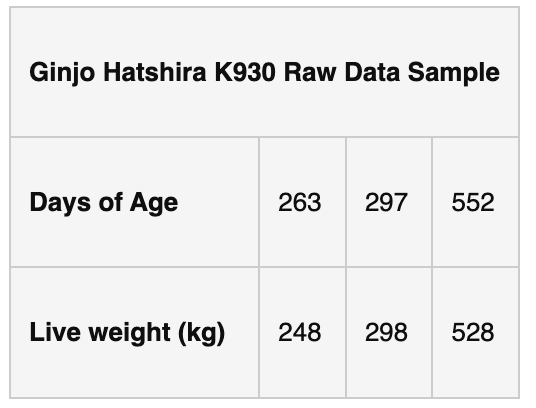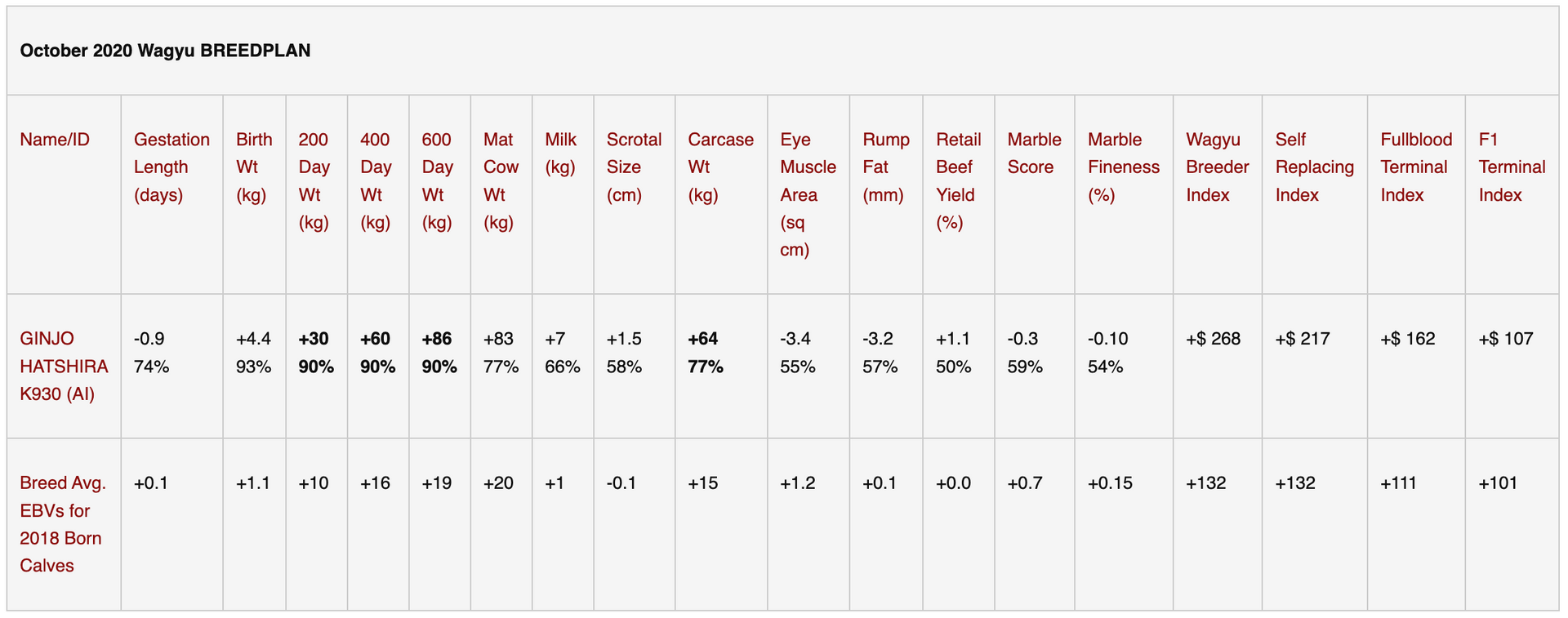Ginjo Hatshira K930
Ginjo Hatshira K930

Carcass Data
Outstanding Marbling Results in First K930 Carcass Data
Initial carcass results from K930 progeny came in from Suzuki Farm in early 2020. Six of the eight were slaughtered at Casino, NSW at an average age of 27 months, after feeding to a Japanese regime focussed on optimised carcass marbling, with reduced emphasis on growth and carcass weight. The average Aus-Meat Marble Score was 9+, with three carcasses scored at 9++ and one at 9+++.
MS7 was recorded against one carcass, being the only one scoring less than MS9, from a dam of 74% Tajima breeding, and with a September 2020 MS EBV of +1.5.. Of similar interest: the dam of the top MS9+++ carcass animal (KSOFL00102) has a Tajima content of around 32% and a September 2020 MS EBV of -0.1. The two other slaughter progeny were fed at Kerwee (Stockyard), both scoring Aus-Meat MS 9++ at a close to industry-.average age at slaughter around 31 months, with an average carcass weight of 486kg.
Unfortunately, none of this carcass data is acceptable as ‘BREEDPLAN compliant’ due to issues with ‘contemporary groups’.
Background
Ginjo Hatshira K930 is now our most popular AI sire and is an AWA EBV trait leader at high accuracy levels. For example, in September 2020 he was the only AWA BREEDPLAN ‘semen available’ sire with a CWT EBV of more than +60 at an accuracy of more than 75%. He is also no ‘one-herd wonder’, with over 220 progeny registered across 10 herds, excluding international progeny.
K930 sire Kitahatsuhi 97/1 represents the best in high performance breeding by Westholme (For more Kitahatsuhi 97/1 details, see the background summary for Ginjo Kitahatsuhi L9 in our current sire listing above). Major growth influences in the pedigree include the Tottori female Hatsuhi, the famous Dai 20 Hirashige line sire Hirashigetayasu, and TF147 Itoshigefuji.
On the K930 dam side is our international AI sire Ginjo MarbleMax Hiranami B901, (According to an AGBU Sept 2020 webinar hosted by AWA, B901 is the #7 most influential sire in the last five year AGBU measurement period, from a field including all international foundation sires, including Michifuku and Itoshigenami). B901 earlier outperformed his internationally famous sire Hirashigetayasu in Australian longfed fullblood carcass research from around 2012. K930 is another generational increment.
As a recessives-free choice (with half-sib Ginjo Kitahatsuhi L9) K930 delivers a unique opportunity to harness Kedaka/Tottori genetics for enhanced performance and genetic diversity. In prefectural analysis, K930 is approximately 42% Tajima; 30% Tottori/Kedaka; 10% Itozakura; 10% Okayama plus traces.
Growth For FB Feeder Production
In September 2020 AWA BREEDPLAN (see download summary below), Hatshira K930 was the clear national herd leader for a ‘semen available’ /AI Sire in 200 day growth and 400 day growth with accuracy of 75% or more. He was the only ‘semen available sire’ meeting these parameters. These are key growth traits in which feeder producers need high performance to help reduce growout costs. Early growth performance of the young K930 is illustrated in the following raw data table – our apologies for not being more energetic with the scales early in his career.
(Click for larger picture).
Marbling
The first progeny carcass data from K930 was received from Suzuki Farm in 2020, with six of eight carcasses scoring AUS-MEAT M9+ or more. Six of the eight progeny (Suzuki Farm feedlot) were slaughtered at substantially less than average days of age for slaughter, average around 27 months. The two older (Kerwee feedlot) carcass progeny were slaughtered at average 31 months of age, both with MS9++ marble scores. Unfortunately, due to group sizes, this carcass data is not eligible for AWA BREEDPLAN.
The Package
K930 offers FB and higher content breeders the opportunity to boost early growth performance and achieve high carcass MS even in shortened feeding programs. In herd development, there is the opportunity to capture important genetic diversity from the Kedaka/Tottori prefectural bloodline that has formed the backbone of Japanese national production since the 1950s. Both sides of this pedigree support confidence for outcomes that will provide substantially enhanced production economics in feeding and breeding. In the Australian national herd environment, numerous high Itozakura/Tajima pedigrees offer ideal joining options.
GINFK0930: AWA BREEDPLAN EBV Summary. Downloaded 20 Sept 2020. (Click for larger picture).
Let’s Talk About Your Wagyu Breeding Plan
We'll Find the Right Wagyu Breeding Solution for You
Call us:


